
One of the many side effects of spending more time at home during the pandemic is a boom in products designed to help you get a better workout outside of the gym.
Peloton reaped the benefits of the early home workout craze and has now fallen on harder times as everyone who was going to buy a fitness bike has gotten one. Meanwhile, other companies like Tempo have tackled the thirst for home gym equipment by offering entry-level versions of their high-tech workout gear. Bringing in more customers and dealing with the silicon constraints posed by the chip shortage in the same fell swoop.
The $495 Tempo Move is a clever example of that very idea. Rather than rely on the expensive camera sensors, chip, and display of the larger Tempo Studio, the company is using the advanced bundle of sensors plenty of people already have in their pockets: an iPhone (sadly, there’s no support for Android phones). The Tempo Move is essentially a small cabinet of weights that you mount your iPhone on so it can track your workouts. I’ve been using it on and off for the last several weeks and save for a few quirks, it really is as cool as it sounds.
Input may receive a portion of sales if you purchase a product through a link in this article. We only include products that have been independently selected by Input's editorial team.
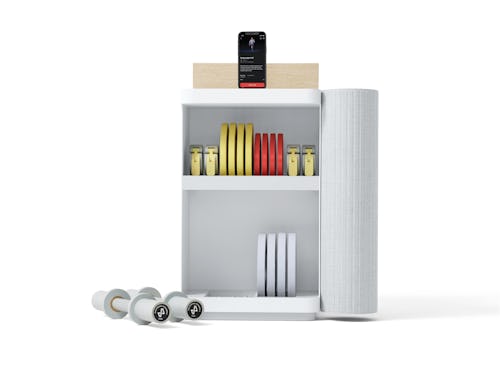
“The Core” of it all
At its most basic, the Tempo Move uses your iPhone’s camera to create and track a wireframe skeleton moving color-coded weights along to Tempo’s fitness classes. Tempo assures me that’s the extent of the visual information that’s collected from you. No need to worry about the company having a video of you struggling. Using this system Tempo can know how many reps you’ve completed, what weight you’re lifting, and unlock insights on how you’re doing during live classes. Otherwise, it’s a nice cabinet with a magnetic fabric door that seems to take inspiration from Apple's iPad Smart Cover.

The Move comes in two different colors with either a dark or light wood finish and is itself modular, to a certain extent. While it’s easiest to just set up the Move in front of whatever TV is connected to its HDMI-cable, a little cabinet of weights might not be the most appealing thing to have plopped down in the center of your living room. Luckily, the component of the Move that actually connects to your iPhone — “The Core” as Tempo calls it — can be removed from the cabinet and placed wherever you see fit. That way the cabinet can be moved to the side and the Tempo can still track your workout (and charge your phone) like normal.
The setup process walks you through finding the best height and space for using the Move, but in my experience, the whole system is simple enough that you shouldn’t be afraid to experiment. Unplug it, plug it back in, find the best placement for you and your room.
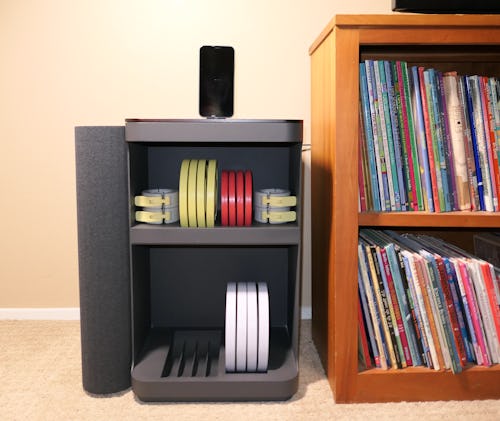
What is a little cabinet without things to store in it? The Tempo Move comes with two 7.5-pound dumbbells (with their own slot at the back of the cabinet), four weight collars, and a collection of “smart weights.” The weights break down into a couple of different options, each covered in a rubbery, scuff-resistant color coating so your iPhone knows what to look for. There are four red 1.25-pound weights, four yellow 2.5-pound weights, and four white 5-pound weights. Combined with the weight of the dumbbells themselves you can use them to achieve a pretty wide range of options. Tempo also offers additional 10-pound plates for purchase on its website and plans to roll out support for tracking kettlebells and the barbel it already includes with the larger Tempo Studio.
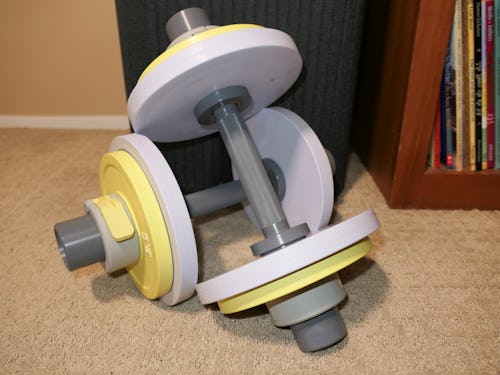
The choice of colors and rubbery coating gives the Move’s dumbbells an almost toy-like quality. They’re very approachable, and there’s nothing hard to understand about getting weights on and off the dumbbells. It’s a bit more work than a normal set or an expensive adjustable option like the Bowflex SelectTech 552 Dumbbells, but such is the price of the at-home smart gym experience.
Powering this whole little system is the HDMI cable connecting the Core and your iPhone to your TV. HDMI cable is a bit of a misnomer. Technically the Move comes with a split cable. On one end is a female USB-A port and on the other, the cable splits into a male USB-A connector (for power) and an HDMI connector. Knowing whether or not your TV or monitor can supply additional power over USB is an important thing to consider with the Move. Most modern TVs do, but if for some reason yours doesn’t, you’ll have to invest in a wall adapter.
App time
All of this hardware would be for nothing without software to make it all work together. Using the Tempo app you can navigate to classes (recorded or live), enroll in a variety of exercise programs designed for whatever your specific goals might be, and track your progress over time. That’s assuming the number of calories you burn or the total amount of weight you’ve lifted are pieces of data that matter to you.
The app works but also doesn’t really get more complicated than that. Most of the time you’re not using the Tempo app much longer than the few seconds it takes to select your next class and connect it to the TV. Occasionally, after connecting my phone I’d run into an issue where classes were playing without sound, but power cycling the Core — unplugging the HDMI and USB connectors and then plugging them back in — always made things work again.
While your iPhone is connected to the TV, you’re in class, presented with an instructor in a “Workout Void” (terminology entirely mine) surrounded by a few key stats your phone and Tempo are collecting. On the bottom left are reps and pace (basically the amount of time it takes you to complete a rep). On the top left is the amount of time left in the current warm-up, lift, or rest period and the current weights you’re using. On the top right is a leaderboard of other people who are doing the workout and their current score (you get points for completing the number of reps assigned to you). And the bottom right is your current heart rate from your Apple Watch or other connected heart rate monitor.
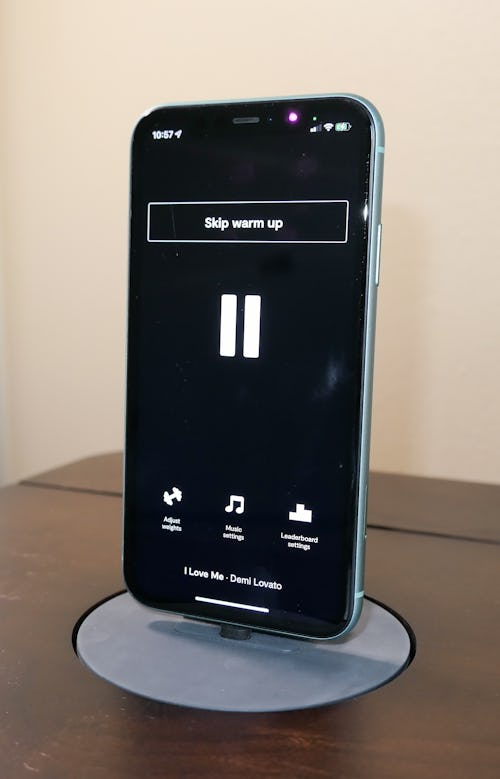
When I first started using the Move, about 90 percent of the time it had no issues tracking how many reps I’d completed. The other 10 percent of the time, it'd miss a rep here or there, or just not track them at all. I first noticed it on movements that required me to lift the weights to shoulder height or above. I could attribute those mistakes to a couple of different causes. I’m 6’3’’, so I might just be approaching the upper limits of what the Move can comfortably see. I’ve also set up the Move in a home office that’s definitely less well lit than other parts of the house. I don’t really see this as a catastrophic failure because it doesn’t impact the quality of the class, just Tempo’s ability to keep score. As soon as I moved the Core back into the Move’s cabinet it went back to tracking everything without an issue, so you should be mindful about placement.
The Move seemed best equipped to know when I wasn’t completing the full range of motion of a specific movement...
The other aspect of the Move, analyzing and helping you adjust your form, is less satisfying. I was surprised overall by how minimal those corrections were. The Move seemed best equipped to know when I wasn’t completing the full range of motion of a specific movement, but it didn’t offer corrections beyond onscreen text suggestions. I was expecting something a bit more hands-on that could use the wireframe model Tempo made of me to improve my performance. Or that that model would be visible at all, considering how it’s overlaid in some of Tempo’s marketing images.
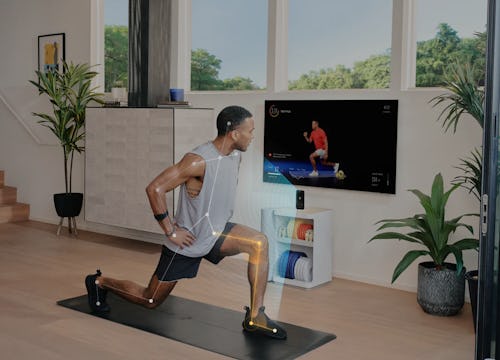
The classes themselves vary in length and type, but so far they’re all things you can do with a mat and/or weights. The kinds of exercises with actual body movements to track. Tempo offers weight training classes, HIIT, yoga, and boxing, but since these are part of an ongoing service, I wouldn’t be surprised if more classes got added down the road. In comparison to a service like Peloton or Apple Fitness+, you’re getting less variety at launch, but those services don’t offer the same promise of intelligent tracking that the Tempo Move does yet. But Peloton is working on it.
Selling personality (and a lifestyle)
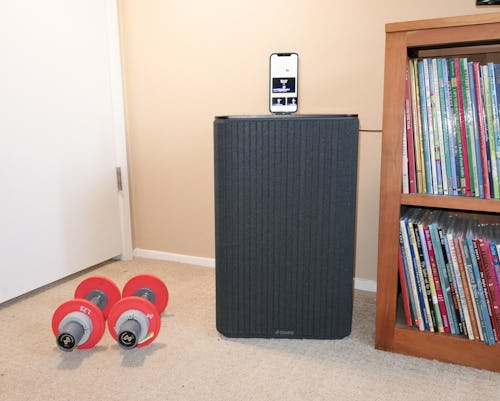
You purchase a product like the Move because you want a “gym-quality” workout from the comfort of your own home, but you stay subscribed to its $39.99/month subscription service because you’ve bought into an idea. It might be that your instructor is your friend, here to personally whip you into shape. Or maybe, that after enough classes, you could look like them, happy and healthy and employed. Or it might be even more diffuse than that: subscribing allows you to participate in a lifestyle that just so happens to also be “healthy.”
Peloton’s whole business (perhaps to a fault) is built on charismatic instructors who become whole mini-industries in their own right. It’s why And Just Like That can joke about Big (Chris North) being in an affair with Peloton’s Jess King because — *SPOILER ALERT* — he rides his bike so much, kill him off, and then Peloton can make an ad featuring Big and King a few days later to save face. You’re not subscribing to just keep riding your bike, you’re subscribing because the people who yell at you to ride it are good at their job.
Tempo doesn’t seem to really be chasing the fitness influencing game.
Apple’s Fitness+ also puts personality front and center. The music is bumping, the studio is in a brilliantly lit, colorful California purgatory (read: Santa Monica) and even though I don’t remember the instructor’s names except for Betina, their energy is definitely what made me like the time I spent there.
In contrast, Tempo doesn’t seem to really be chasing the fitness influencing game. It’s much more mellow in comparison to Peloton or Fitness+, and the Workout Void aesthetic of the classes makes it almost seem like the coaches are living inside my TV, rather than inviting me into some real-life studio. Not to say that Tempo’s coaches aren’t informative, kind, encouraging, or without Instagrams. They’re just not — at least in my experience — going to make me cry tears of inspiration.
And mostly? I prefer that. It means the Move might have less of the magnetic draw of the Peloton Bike+, but to build a lifetime health habit, you might need more than just misplaced affection for your coach to really commit to something. This is also, like adding more class types, something Tempo could change over time. The company has already used Olympic athletes like Lindsey Vonn as guest coaches, so it’s definitely interested in having class instructors be the main draw. Whether that becomes the only draw remains to be seen.

You have to want it
Priced at over $300 means the Tempo Move naturally isn’t for everyone. But when you take into account the normal price of adjustable dumbbells which can span anywhere from $200 to $400 you’re probably getting your money’s worth.
The real deciding factor should be the subscription service. From my experience, Tempo’s classes seem as instructional as any other; you’ll get a good workout and you’ll probably learn something you can take with you for when you exercise on your own. But you should still try it to be absolutely sure — Tempo offers an extended six-month trial period so you can put it through its paces.
After spending my time with the Tempo Move I’m seriously considering getting one of my own, but like any kind of fitness product, you have to really want to do it for it to be worth the cost.







